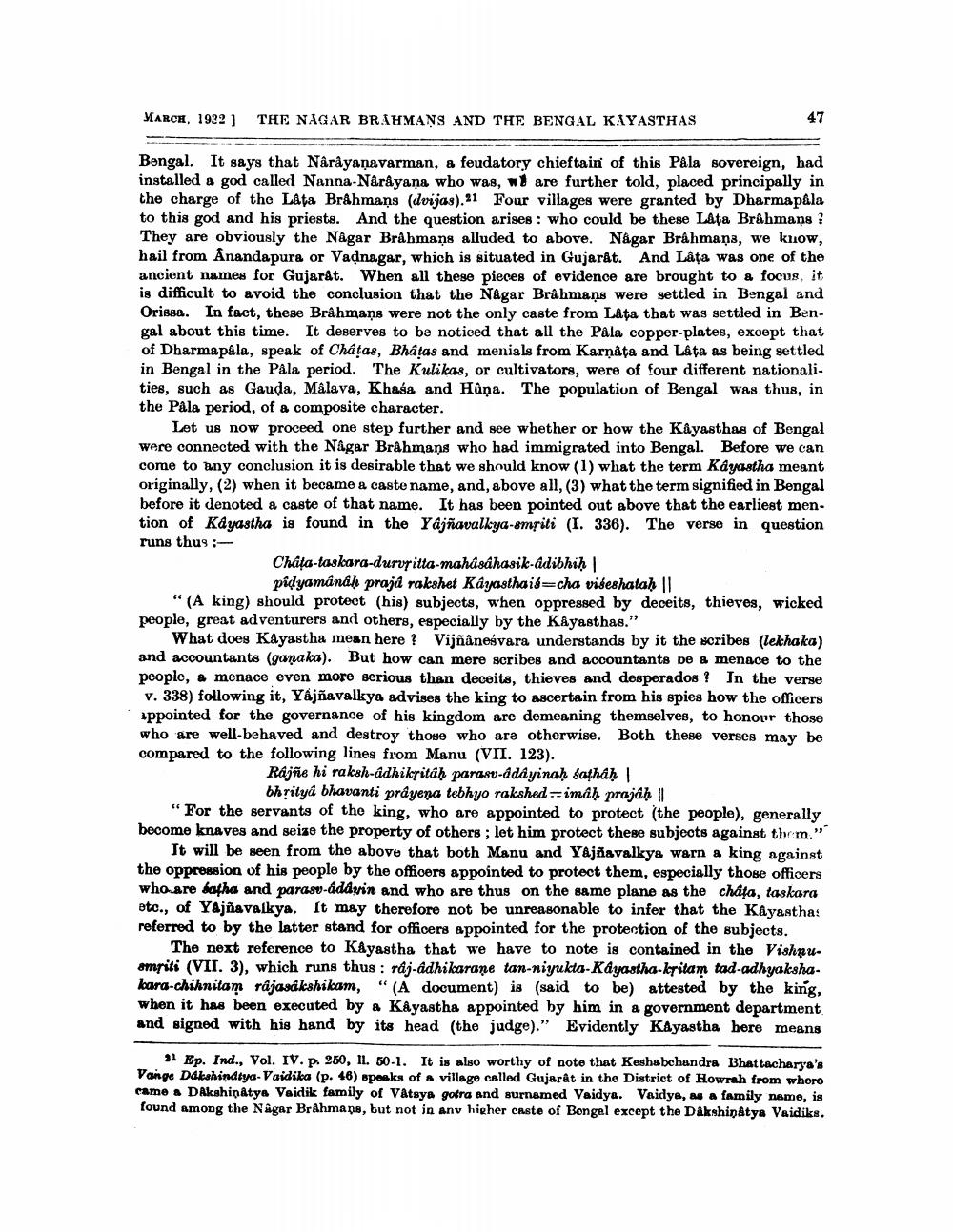________________
MARCH, 1932)
THE NAGAR BRAHMANS AND THE BENGAL KAYASTHAS
47
Bengal. It says that Narayanavarman, a feudatory chieftain of this Pala sovereign, had installed a god called Nanna-Narayana who was, w are further told, placed principally in the charge of tho Lata Brahmans (dvijas).21 Four villages were granted by Dharmapala to this god and his priests. And the question arises : who could be these Lata Brahmans : They are obviously the Nagar Brahmans alluded to above. Nagar Brahmana, we kuow, hail from Anandapura or Vadnagar, which is situated in Gujarat. And Lata was one of the ancient names for Gujarat. When all these pieces of evidence are brought to a focus, it is difficult to avoid the conclusion that the N&gar Brâhmans were settled in Bengal and Orissa. In fact, these Brahmans were not the only caste from Lata that was settled in Bengal about this time. It deserves to be noticed that all the Pala copper-plates, except that of Dharmapala, speak of Chatas, Bhatas and menials from Karnata and Lata as being settled in Bengal in the Pala period. The Kulikas, or cultivators, were of four different nationalities, such as Gauda, Mâlava, Khasa and Hùņa. The population of Bengal was thus, in the Pala period, of a composite character
Let us now proceed one step further and see whether or how the Kayasthas of Bengal were connected with the Nagar Brâhmans who had immigrated into Bengal. Before we can come to any conclusion it is desirable that we should know (1) what the term Kayastha meant originally, (2) when it became a caste name, and, above all, (3) what the term signified in Bengal before it denoted a caste of that name. It has been pointed out above that the earliest men. tion of Kayastha is found in the Yajñavalkya-smriti (I. 336). The verse in question runs thus :
Chafa-taskara-durupitta-mahúsáhasik-adibhiḥ |
pidyamándh prajd rakshet Kayasthais=cha viseshatah 11 "(A king) should protect (his) subjects, when oppressed by deceits, thieves, wicked people, great adventurers and others, especially by the Kayasthas."
What does Kayastha mean here? Vijñanesvara understands by it the woribes (lekhaka) and accountants (ganaka). But how can mere scribes and accountants be a menace to the people, & menace even more serious than deceits, thieves and desperados? In the verse v. 338) following it, Yájñavalky& advises the king to ascertain from his spies how the officers appointed for the governance of his kingdom are demeaning themselves, to honour those who are well-behaved and destroy those who are otherwise. Both these verses may be compared to the following lines from Manu (VII. 123).
Rajñs hi raksh-adhikritáh parasu-adayinah sathah
bhritya bhavanti prâyena tebhyo rakshed-imâh prajâh || “For the servants of the king, who are appointed to protect (the people), generally become knaves and seize the property of others ; let him protect these subjects against them."
It will be seen from the above that both Manu and Yajšiavalkya warn a king against the oppression of his people by the officers appointed to protect them, especially those officers who are safha and parasu-dddgin and who are thus on the same plane as the châta, taskara etc., of Yajñavalkya. It may therefore not be unreasonable to infer that the Kayastha: referred to by the latter stand for officers appointed for the protection of the subjects.
The next reference to Kayastha that we have to note is contained in the Vishnuamriti (VII. 3), which runs thus : rdj-adhikarane tan-niyukta-Kayastha-kritam tad adhyakshakara-chinnitam rajasdkshikam, "A document) is said to be) attested by the king, when it has been executed by a Kayastha appointed by him in a government department and signed with his hand by its head (the judge)." Evidently Kayastha here means
31 Ep. Ind., Vol. IV. p. 250, 11. 50-1. It is also worthy of note that Keshabchandra Bhattacharya's Vange Dakshindtya. Vaidika (p. 46) speaks of a village called Gujarât in the District of Howrah from where came DAkshinatya Vaidik family of VAtsya gofra and surnamed Vaidya. Vaidys, as a family name, is found among the Nagar BrAhmaps, but not in any higher caste of Bongel except the Dakshingtya Vaidiks.




